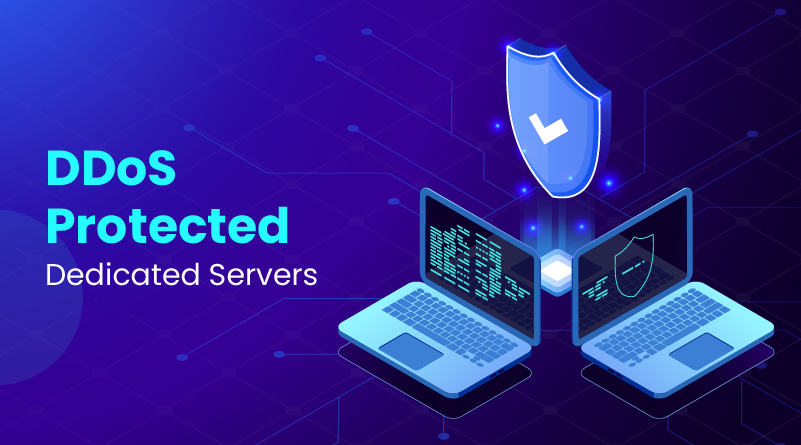A dedicated server allows you to access the entire server for your application, websites, and business – all to yourself. However, the security of dedicated servers is a real concern for the owners nowadays and one major threat is DDoS attacks. This attack has a major impact on the companies dependent on the internet for their business and production work. Many famous websites like Yahoo experienced a DDoS attack in early 2000.
A DDoS attacker can degrade the quality of the dedicated server or fully break down the network connectivity of the victim. The main intention of a DDoS attack is to make the user of that server partially or unable the use resources like CPU, RAM, storage, and other network resources.
This article illustrates some safe practices for protecting your website from a DDoS attack.
Related: How To Pick The Right Dedicated Server Specs?
What Is A DDoS attack?
A distributed denial-of-service (DDoS) attack is an evil attempt to disturb the normal functioning of a targeted dedicated server. This attack spoils the normal traffic, network, or service by overwhelming the target or its surrounding infrastructure with a flood of internet traffic. DDoS attacks become successful by using many compromised or unprotected computer or server systems as sources of attack traffic. To be more precise, a DDoS attack is simply like an unexpected traffic jam caused by unreal users to prevent authentic users to reach their destination, your application, or website.
How To Identify A DDoS Attack?
DDoS attacks have some common symptoms. The most common symptom is an application or website suddenly becoming unavailable or extremely slow. However, it can be caused by a legitimate spike in traffic during peak hours of your dedicated server. It is advised to use traffic analytics tools to spot some common signs of a DDoS attack:
- Suspicious amounts of large traffic coming from a single IP range or IP address.
- A flood of traffic from users sharing a single behavioral profile, like device type, web browser version, or geolocation.
- Odd traffic spikes or patterns; such as unexpected traffic at odd hours of the day or unnatural patterns (like traffic spikes after every 20 minutes).
Related: Do You Really Know Everything About The DDoS Attack?
Understanding The DDoS Attack
The DDoS attack is launched to attack the victim server in the following forms:
- The attacker finds some weakness or bug in the software implementation to disrupt the service.
- Some DDoS attacks deplete the entire bandwidth or resources of the system of the victim.
The attackers scan the network to find the most vulnerable machines and then those machines are used as agents by the attacker. Attackers compromise the security of the hosts to launch DDoS attacks using spoofed IP addresses, which makes it difficult to trace the attack source.
Classification Of DDoS Attack
Many variations of DDoS attacks are sprouting the whole cloud network of dedicated servers. Two major types are related to bandwidth and resources. Depending upon the exploited vulnerability the DDoS attack can be further divided into different types.
- Bandwidth Depletion Attacks: In this case, the attack uses the bandwidth of the victim or target system by flooding the unwanted traffic. This activity prevents legitimate traffic from reaching the application or website hosted on your dedicated server.
- Flood Attacks: This type of attack is launched by an attacker by sending a large amount of traffic to the victim server. As a result, the victim’s network bandwidth with IP traffic is clogged up. The victim server experiences a saturated network bandwidth and slows down quickly to prevent legitimate traffic to access the network. Flood attacks are initiated by ICMP (Internet Control Message Protocol) and UDP (User Datagram packets).
- Amplification attacks: Here the DDoS attacker sends a large number of packets to a broadcast IP address. Hence, the systems in the broadcast address range to send a reply to the victim system. As a consequence, malicious traffic is caused. This type of attack can be launched either by the attacker directly or with the help of zombie machines. Well-known types of this attack are Smurf and Fraggle attacks.
- Resource Depletion Attacks: The DDoS resource depletion attack targets the resources of the dedicated server to make it paralyzed and incapable to serve legitimate users.
Some common examples are:
- Protocol Exploit Attacks
- Malformed Packet Attacks
- IP Address Attack
- IP Packet Options Attack
What Is A DDoS-Protected Dedicated Server?
DDoS-protected dedicated servers use hardware and software to detect and mitigate DDoS attacks. A DDoS-protected server will have a shield on your server to protect your website or web service from malicious DDoS attacks causing website crashes leading to financial loss. A DDoS-protected server is considered best for ecommerce and gaming sites that are most prone to DDoS attacks.
Mechanism Of DDoS Protection
Various countermeasures have been adopted and still emerging to protect dedicated servers from a DDoS attack. Most DDoS attacks are caused by an intruder attempting to make unauthorized access to the victim’s dedicated server. Some common DDoS protection mechanisms are discussed below:
Prevention Techniques: Prevention is always better than cure! The same concept applies to the method of protecting the dedicated servers from DDoS attacks. One such method is to use filters, like:
- Ingress filtering
- Egress filtering
- Route based distributed packet filtering
- Secure overlay services (SOS)
Other common prevention techniques are applying security patches, changing IP addresses, disabling IP broadcasts, disabling unused services, load balancing, and honeypots. This prevention technique is not able to completely remove the risk of DDoS attacks on a dedicated server but increases the security.
Detection Techniques: This method helps the victim to avoid the spread of DDoS attacks and prevents the servers from crashing. The common methods are:
- Anomaly detection method
- Running NOMAD, a scalable network monitoring system
- Packet sampling and filtering technique
- Using MULTOPS, a data structure designed to detect and prevent DDoS attack
- Misuse detection
Response To Detection: In case your dedicated server is under a DDoS attack, the next task is to block the attack and the attacker should be traced to find out the attacker’s identity. It can be done in two ways, manually using ACL (Access Control List) or automatically.
Factors To Consider In Defense Mechanism
Before selecting desired DDoS solution for your dedicated server many things need to be considered; like:
- Functional: The solution mechanism should be functional enough. It should have the ability to reduce the impact of the attack irrespective of how powerful the attack is.
- Transpicuous: The technique must be easy to implement. It would need a dedicated IT resource team to modify the existing network and its infrastructure.
- Lightweight: Most importantly the solution should not overload the system.
- Precise: The chosen solution should not promise lots of false positives. Many methods need the real traffic to be dropped, which is not the desired solution.
Instances Of DDoS Protected Dedicated Server
DDoS protected dedicated servers are crucial to stop the attacks of malicious hackers. The common servers prone to this attack are found to have a lot of active users, or websites generating lots of revenue. Let’s have a look at the most common cases where a DDoS protected dedicated server can be most useful.
- Gaming Servers: Gaming servers are a common target for DDoS attacks as the online community of e-game users is extremely large. Hackers often try to attack servers of most popular games like Half-Life, Team Fortress, Minecraft, and Counter-Strike.
- Ecommerce Servers: DDoS attacks on ecommerce servers can cause huge downtime (for hours, even for days) preventing real customers to view and buy your products. This can also lead to server crashes.
- Online Banking Servers: Online banking servers do online money transactions and use their dedicated servers to save sensitive information like credit card and debit card details. In worst cases, a DDoS attack can refrain your valued customers to access their hard-earned money on the server.
- SaaS Application Servers: In the case of SaaS business, the hosted application generates all your revenue. DDoS attacks on this type of server can cause frequent and huge downtime resulting in loss of customers and revenue.
- Email Servers: Most professional business houses use dedicated email servers, which are most prone to DDoS attacks. A hacker can simply send a DDoS attack after finding your IP address.
Related: How To Pick The Right Dedicated Server Specs?
Conclusion
One major threat to the network used by e-commerce, e-communication, e-government, e-learning, and e-sport websites is a DDoS attack. This attack is at a constant rise in dedicated servers and cloud computing. This article provides a brief survey on DDoS attacks, their types, and various countermeasures like detection, prevention, and tolerance techniques to prevent the attacks. If you don’t have a dedicated IT resource team to do the same, it is recommended to host on a DDoS protected dedicated server.















